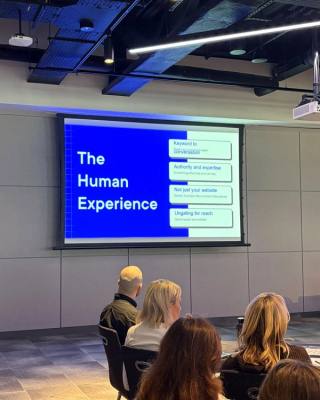It may sound odd, but it is absolutely true: many organisations find it extraordinarily hard to talk about what they do. Or alternatively, they find it very easy to talk about what they do, but hard to communicate effectively with prospects, customers and partners.
“Communicate” is of course the key word here. Communication involves two parties, and an idea or concept has only been communicated when the listener has absorbed and understood what the speaker is trying to say. This process is hard enough when carried out face to face. It becomes more difficult again when attempted across the internet to a generic audience rather than a specific individual.
This difficulty is one reason that so much money every year is spent on brand consultants, advertising agencies, copywriters, messaging gurus and so on. We all know what good communication looks like when we see it, and we rely on these individuals and organisations to make it happen.
But of course it isn’t just about the words we use. It is about how we structure information, how we enable the site visitor to navigate through our content, and what options we give them at any particular time. And those are questions that a digital agency like Kooba works through with clients on a regular basis.
So here, from the perspective of a web design and development agency, are 5 recommendations worth taking on board when considering how to communicate as effectively as possible in the online environment. Enjoy!
1. Start from “nobody cares”
It’s terribly easy to write at great length about the details of your product or service. After all, it’s what you know, and in many cases there is a certain amount of emotional investment in the details and features. That’s only natural. Spend 12 months scoping and developing a new feature within a software product, for example, and you are going to start viewing it in a manner usually reserved for a favourite child or sausage dog.
Your prospective customer doesn’t share that viewpoint: or as I put it bluntly above, “nobody cares”. They typically have a job to get done. Start by asking yourself what that is. When you have the answer, structure communication and content to address that need. This is usually a smart way to solve the age-old ‘what do I put at the top of my homepage?’ puzzle.
Better yet, find out what metrics your typical prospects are measured on. It may be hard to get a clear answer to that question, but if you have one, you have a clear read on what they care about and thus what messages they are likely to pay attention to - and attention is the starting point of communication.
2. Have a goal in mind
Along similar lines, take the time to take a clear look in the mirror and answer the following question: “what do I want my audience to believe?” Again, this gives a structure to the way in which you communicate. In conjunction with point 1 above, by following this process you should find yourself able to articulate what your prospects care about, and what you would like them to believe about those topics that will help your organisation sell.
When you have reached that place it becomes easy, or certainly a lot easier, to create content and make calls about how to prioritise your messaging. The alternative is to write and design without focus and without a clear picture of the end result: that makes your job harder, and your online presence less effective.
3. Limit choice - all other things being equal
If we have a clear understanding of our audience, and a clear understanding around what we want them to believe, then it stands to reason that to at least some extent we need to guide the conversation. And to do that, we should probably limit the amount of choice we give the site visitor.
This isn’t about hiding information, but rather about curating the experience and creating clear, logical pathways through an online presence that help build understanding in a natural and gradual way. It helps to envisage the alternative: offering a bewildering choice of options almost immediately, with no indication as to a logical place to start, and no clear hierarchy between them.
Many navigation decisions are ultimately not so far removed from this approach. It is the default result of following a ‘path of least resistance’ and saying yes to every internal request for some real estate within the nav or on the homepage. It is hard to say ‘no’, but it is what is required if we wish to ensure we communicate effectively. We must ask ourselves what we really need to say now, and what can wait until later.
Lastly, when you do offer choice, do so in terms that reflect the ‘jobs’ the site visitor has and their own way of viewing the world. Talk in terms of benefits or the attributes of the visitor themselves. Don’t expect visitors to understand your own esoteric product terminology and make informed decisions based on it.
4. Show, don’t tell
The first lesson in film school applies equally as well online. I suppose we would say that, but nevertheless that doesn’t stop it being true. The online world now supports fabulously rich interactions and almost any form of visual design you can imagine. Smart communicators understand that a picture is worth a thousand words and make sure to integrate language and design into an organic whole that is infinitely more effective than words alone.
To make that happen for your business, make practical changes to your process. Resist the temptation to ‘write the content’ before any input from your design team (or digital agency). Instead, think from day one about how words and images will work together to tell your story. On the other hand, whilst smart images and interactive experiences can be incredibly effective communication tools, they can also overwhelm or confuse the user. This is one area where testing alternative approaches makes a lot of sense - just make sure you are getting feedback from the right people!
Of course there are situations when longer chunks of text and text alone are welcome. This blog is one of them. But when it comes to communicating, use every medium you have available to you. Be creative.
5. Support curiosity
Allow site visitors to follow their natural curiosity rather than insisting they come to terms with a formal ‘navigation structure’ that only adds mental load to what is likely to be their core focus: finding out whether your business can help them.
What that means is delivering content in short, digestible blocks (at least at first) and letting the user decide in context whether they wish to know more about this particular topic. Or in other words, the “Read More” or “Learn More” button seen within the page itself rather than as part of a formal navigation.
Yes, this is reasonably obvious - but you would be surprised how many organisations still don’t employ this approach. And although it sounds simple it actually has a profound impact in terms of giving a real sense of control to the user. Whilst we should make some effort to establish ‘typical’ requirements and design accordingly, we must remember that each visitor to the site is an individual with individual ‘jobs to be done’. Allowing them to follow their own curiosity will help them - and you - succeed.








